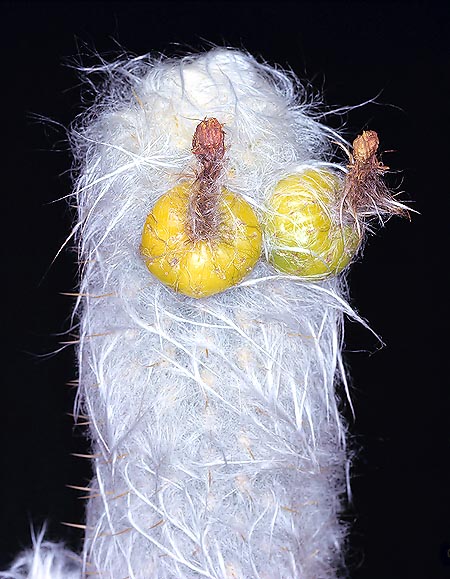Family : Cactaceae

Text © Pietro Puccio

English translation by Mario Beltramini
The plant is native to Chile (Arica, Tarapacà and Antofagasta) and to Peru (Arequipa, Ayacucho, Moquegua and Tacna), where is frequent in rocky semi-arid and stony areas of the Andean pre-cordillera, between the 2.000 and the 4.000 m of altitude, characterized by a cool and dry climate in winter, mild and little rainy in summer.

Oreocereus leucotrichus with fruits. May be 2 m tall © Giuseppe Mazza
Common names: “cactus blanco”, “cardόn blanco”, “chastudo”, “chastudo peludo”, “chica-chica”, pichaja”, “quisco”, “tunilla”, “viejito” (Spanish).
The Oreocereus leucotrichus (Phil.) Wagenkn. (1956) is a much variable columnar plant, ramified at the base, with stems tall up to about 2 m and green to grey-green epidermis.
The stems, of even 12 cm of diameter, have 10-18 smooth ribs with areoles provided with several silky hairs of white colour, thicker on the more recent vegetation, of 1 to 4 central thorns, long up to 8 cm, of pale yellow to reddish brown colour, and 5-12 radial, shorter, thorns, of the same colour.
The flowers, diurnal, generate in small groups from the areoles at the apex of the branches, are 8-10 cm long with straight, or slightly curved, floral tube, of red colour with densely pilose areoles, and 3-5 cm of diameter corolla with dark red or purple red tepals and several dark purple stamina.
The globular to ovoid fruits with a diameter of 4-6 cm have a yellowish green colour, with thin epicarp (skin) and slightly acid pulp. The plant reproduces by seed and by cutting, provided left drying up well, in summer.
It is a much decorative plant and of fairly reasonable dimensions, both in height and breadth, therefore suitable for small “desert” gardens, in association with other xerophytes. It requires full sun and particularly draining substrata, as it is very sensitive to rottenness when in presence of humidity and low temperatures, which may be formed, in equal quantities, by common fertilized garden earth, coarse sand and crushed stone.
In summer, during the vegetative period, it must be regularly watered, but allowing the substratum to completely dry up before irrigating again; in winter, it’s to be kept dry and, even if standing, in its origin countries , temperatures as low as -5/-7 °C, it is better not to expose it to below 0 °C, especially if in presence of high atmospheric humidity.
Where the open air cultivation is not possible due to the climate, it is to be cultivated in pot, with the same aforementioned modalities, in order to shelter it in winter.
This plant is inscribed into the appendix II of the Cites (plant whose trade is ruled at international level).
Synonyms: Echinocactus leucotrichus Phil. (1891); Arequipa leucotricha (Phil.) Britton & Rose (1922); Oreocereus hendriksenianus Backeb. (1958); Oreocereus hendriksenianus var. densilanatus Rauh & Backeb. (1958); Oreocereus hendriksenianus var. spinosissimus Rauh & Backeb. (1958); Oreocereus ritteri Cullman (1958); Borzicactus hendriksenianus (Backeb.) Kimnach (1960); Borzicactus leucotrichus (Phil.) Kimnach (1960); Morawetzia varicolor Knize (1968); Oreocereus knizei Hewitt & Donald (1975).
